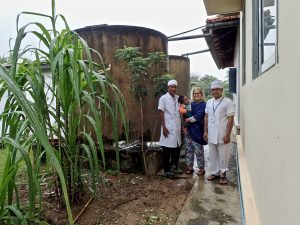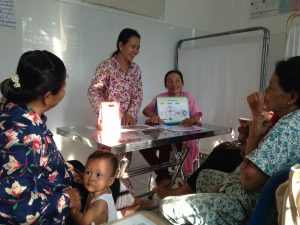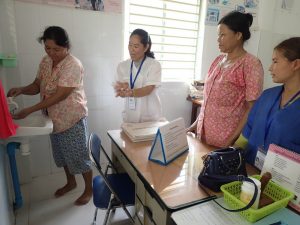This project is made possible through the partnership of WATER CHARITY and the NATIONAL PEACE CORPS ASSOCIATION. ![]()
 Location
Location
Takeo Province, Cambodia
Community Description
The community to benefit from this project is a vibrant, rural commune in rural Takeo Province. Everyone is ready to greet with a smile and a joke in between fishing, rice-planting, and family duties. The commune’s villages sprawl out along the shore of an expanse of flood lands across which a view of several mountains can be enjoyed.
At the nucleus of this community lies its health center, staffed by 10 exceptionally compassionate and dedicated local health care providers. Given that the provincial hospital is as far as 18 kilometers of the unpaved road away for some community members, the health center is the preeminent provider of health care. Of the average 9,497 patients who it serves annually, 71% are women and children under 5 years old. This number of patients represents 69% of the total commune population and the majority of services provided (prenatal, maternity, and consultation) require staff-to-patient contact.
Problem Addressed
In 1997, a water system comprised of 2 wells was built behind the health center. However, the water pressure is unreliable. Although there are new, functional hand-washing stations equipped with soap in nearly every room of the health center, water pressure is often insufficient to deliver water to the sinks.
Knowledge of proper hand-washing technique and purpose is strong among staff members; they merely lack water with which to do so. Previously, water at the health center was accessed via a single faucet behind the main building directly between the existing wells and the latrines. Water was stored in buckets throughout the health center and frequently changed, although this bucket-water was rarely used for sanitation purposes.
] Recently four new hand-washing stations were built throughout the health center. These were funded by the Cambodian Ministry of Health and were awarded due to the existing water system at the health center. However, the water pressure from the good system has proven insufficient to deliver water to each of the hand-washing stations, many meters away from the wells. Although staff members instinctively turn to these sinks to wash their hands throughout the day, water flows from the faucets approximately half the time.
Recently four new hand-washing stations were built throughout the health center. These were funded by the Cambodian Ministry of Health and were awarded due to the existing water system at the health center. However, the water pressure from the good system has proven insufficient to deliver water to each of the hand-washing stations, many meters away from the wells. Although staff members instinctively turn to these sinks to wash their hands throughout the day, water flows from the faucets approximately half the time.
Currently, staff members are forced to treat upwards of 30 patients – the sick elderly, small children, and pregnant women – every workday.
Project Description
This project will build an elevated cistern, and install a pump and piping system, which will ensure the consistent presence of water in all areas of the health center.
Available water is expected to increase the frequency of HWWS (hand-washing with soap) among staff members before and after more routine patient contact points.
To promote proper hand-washing techniques and other sanitary water practices throughout the community, the midwives have agreed to lead two trainings for the village health volunteers (VHVs), with the help of the remaining staff members, deputy chief, and health center director.
When these initial trainings is complete, the VHVs will lead training with local families in their respective villages concerning hand-washing and water treatment. It is the hope of this project that the exemplary hygiene exhibited by the health center staff during their training-of-trainers and routine health care provision – as well as a physical structure that promotes proper sanitation practices and importance of clean water – will catalyze improved sanitation in the surrounding rural community.
The outcomes of this project will include a reliable water source for all sections of the health center and increased knowledge of 1) common routes of fecal-oral contamination and 2) critical times to hand-wash with soap among health center staff, VHVs, and families who participate in the village training. This knowledge is expected to lead to improved hygiene practices in the homes of participants who will then propagate their knowledge and skills gained to their neighbors and relatives.
 Construction supplies will be purchased by the HC staff during the first midwife-led training with the staff and VHVs. The Peace Corps Volunteer will assist in lesson planning for this initial training.
Construction supplies will be purchased by the HC staff during the first midwife-led training with the staff and VHVs. The Peace Corps Volunteer will assist in lesson planning for this initial training.
Construction of the water-tower will begin upon completion of this initial training. VHVs will select families for participation in their village training during vaccine outreach days in their respective villages.
Water Charity funds will be used for materials and skilled labor.
Project Impact
About 4,000 people will benefit from the project.
Peace Corps Volunteer Directing Project
Kelsey Swalwell
Monitoring and Maintenance
Regarding maintenance, many welders and repairmen own shops throughout the village in which the health center is located. Any issue with water tower functionality can be easily resolved by way of local workmen and a portion of the monthly stipend provided by the Ministry of Health (MoH) for grounds upkeep. This MoH stipend is meticulously managed by the health center’s vaccinator who has been a trusted cashier and groundskeeper at the health center for decades.
Additionally, educational materials such as visual aids have long lifespans at the health center where they are kept in pristine cabinets in between uses. Thus, it is expected that the visual aids created for this project will be useful for years to come.
Finally, each staff member has already offered different ways they can work HWWS and water-treatment education into their usual patient contact points, i.e. the pharmacist can inquire about soap used in the home for frequent diarrhea patients and the vaccinator knows to consider HWWS and water-treatment education for caretakers whose children are frequently ill and underweight.
Between the routine health promotion performed by the VHVs and the new conversations started about HWWS on the part of the health center staff, hand-washing with soap is expected to become a topic that is not only on the community’s radar but one that will be met by improved HWWS practices in the home.
Project Funding
This project has been paid for through the generosity of the International Foundation.
Funds raised in excess of the project amount will be allocated to other projects in the country.